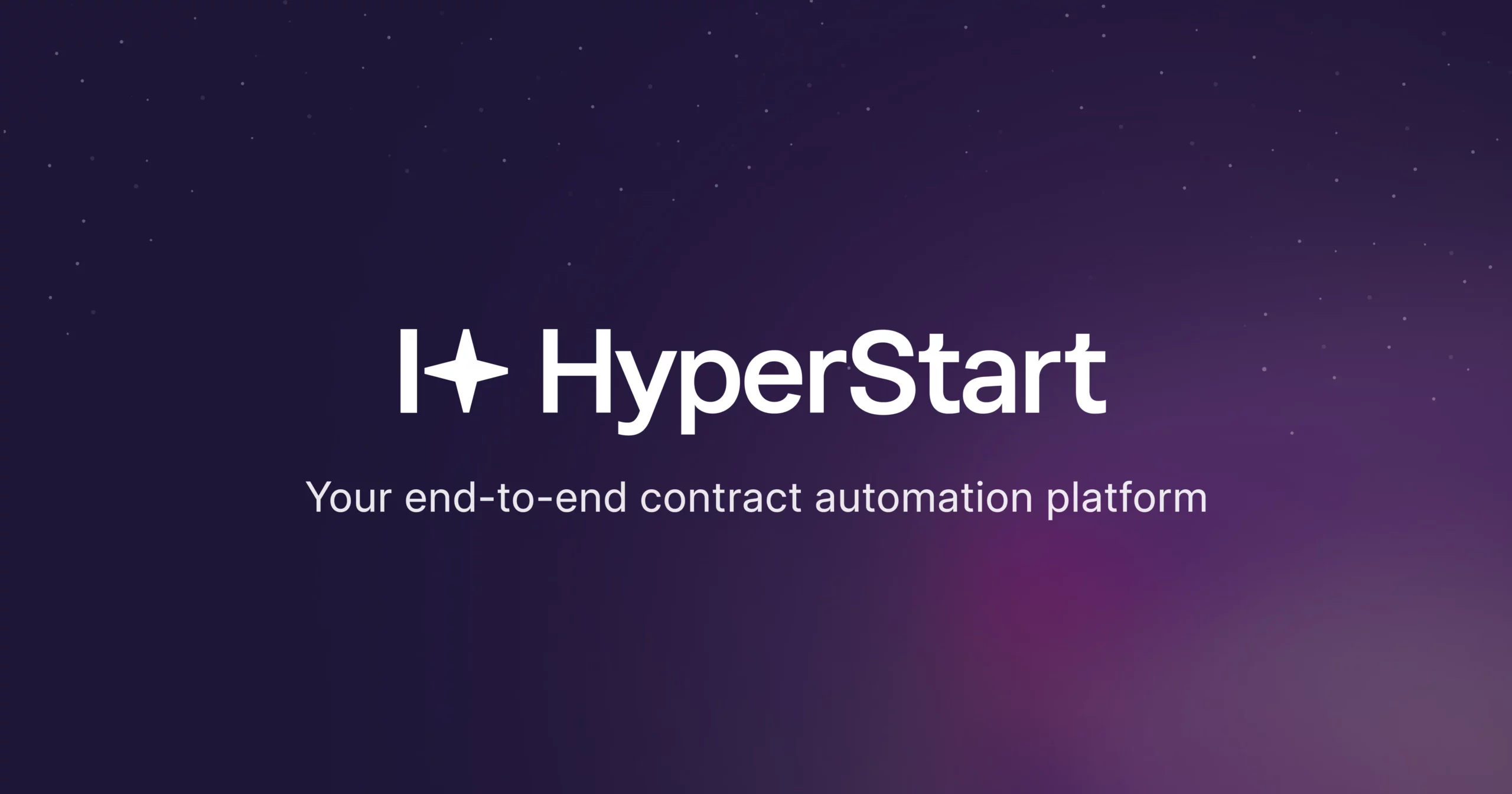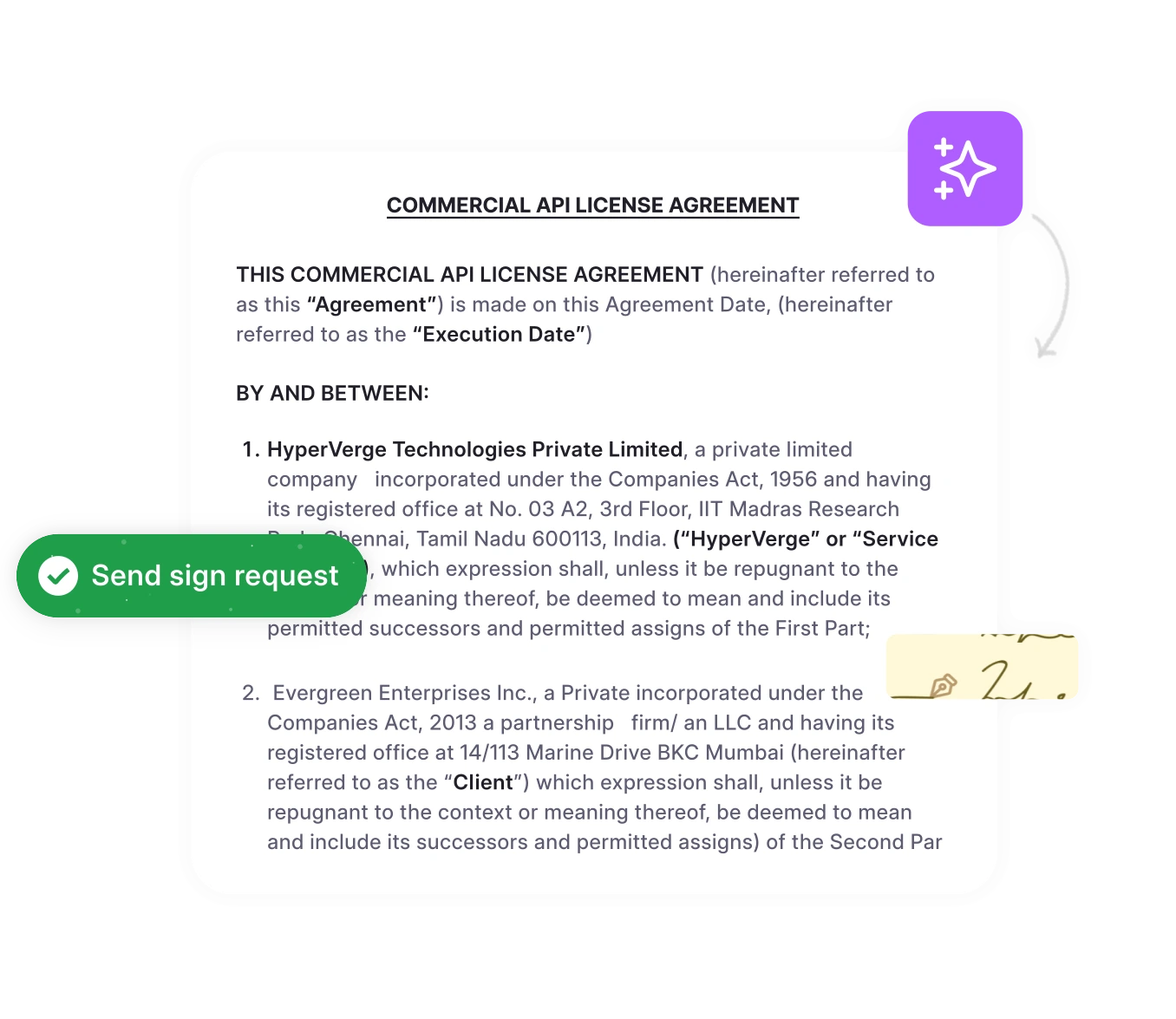Managing supplier relationships and procurement transactions requires clear documentation and legal protection. Businesses face confusion about when purchase orders become binding contracts, what does PO mean in different contexts, and how to avoid costly disputes with vendors.
This comprehensive guide covers everything you need to know about purchase order agreements, from core definitions and legal requirements to process workflows and management best practices. You’ll learn how POs function as contracts, what components are essential, and how modern procurement contract management streamlines the entire purchasing cycle.
Whether you’re a procurement professional, legal team member, or business owner handling supplier relationships, this guide provides actionable insights for creating, managing, and enforcing purchase order agreements effectively.
What is a purchase order agreement?
A purchase order agreement is a commercial document issued by a buyer to a seller that specifies the goods or services being purchased. What is a PO? It’s the abbreviated term for purchase order, and understanding what PO stands for is essential for anyone managing procurement transactions. When the seller accepts the PO, it becomes a legally binding contract between both parties.
The PO meaning in business contexts refers to this formal offer document that transforms into an enforceable business contract upon acceptance. The key distinction is that a purchase order begins as a buyer’s offer. Once the seller accepts this offer through formal confirmation or by fulfilling the order, the PO creates legal obligations for both parties.
An example of a purchase order in action: if a construction company sends a PO to a supplier for 500 units of steel beams at an agreed price with specific delivery terms, and the supplier ships the materials, both parties are now bound by the purchase order terms. The buyer must pay the agreed amount, and the seller must deliver the specified goods.
Simplify your purchase order process
Automate approvals, tracking, and payments effortlessly with HyperStart.
Book a DemoWhat are the key components of a purchase order agreement?
A comprehensive purchase order agreement contains multiple essential elements that establish clear expectations and legal protection. Understanding these components helps businesses create effective POs that minimize disputes and ensure smooth transactions. The format for purchase order documents may vary across organizations, but certain core elements must always be included.
The table below outlines the critical elements every purchase order should include:
| Component | Purpose | Key Details |
| Buyer & Seller Information | Identifies parties to the agreement | Legal business names, addresses, contact details |
| PO Number & Date | Provides unique transaction identifier | Sequential numbering system, issue date |
| Item Description | Specifies what is being purchased | Detailed product/service specs, quantities, units |
| Pricing Terms | Establishes financial obligations | Unit price, total cost, currency, taxes |
| Delivery Terms | Defines fulfillment expectations | Shipping method, delivery date, location |
| Payment Terms | Sets payment conditions | Payment schedule, method, due dates |
These contract clauses work together to create a complete commercial agreement. Each element serves a specific legal and operational purpose that protects both parties throughout the transaction.
Read also, Stock Purchase Agreements: Back to Basics
A well-drafted purchase order is more than a form — it’s a risk management tool. When aligned with legal requirements and internal controls, it protects both buyer and seller while ensuring accountability across every stage of the procurement cycle.
Read
1. Buyer and seller information
This section identifies all parties involved in the transaction with complete legal details. Accurate party identification prevents confusion about who holds contractual obligations and ensures enforceability.
Include full legal business names, registered addresses, tax identification numbers, and primary contact information. For larger organizations, specify the department or division responsible for the transaction.
2. Purchase order number and date
The PO number serves as a unique identifier for tracking and reference throughout the purchasing cycle. Organizations typically use sequential numbering systems to support internal accounting and audit trails.
The issue date establishes when the offer was made and helps determine timelines for acceptance and delivery. This date becomes critical for calculating payment terms like Net 30 or Net 60.
3. Product or service description
This component provides detailed specifications for the items the buyer is purchasing. Clear descriptions prevent misunderstandings about quality, quantity, or specifications.
Include product names, model numbers, SKUs, technical specifications, service scope, and any quality standards that must be met. The more specific this section is, the stronger the legal protection if disputes arise.
4. Pricing and payment terms
Pricing terms establish the total financial obligation and the method for calculating costs. This includes unit prices, quantity discounts, applicable taxes, and the total purchase amount.
Payment terms specify when and how the buyer will pay the seller. Common structures include Net 30 days, Net 60 days, or payment upon delivery. These terms should align with both parties’ cash flow needs and standard business practices.
5. Delivery terms and schedules
Delivery terms define when, where, and how the seller will fulfill the order. This section protects both parties by establishing clear expectations for shipment and receipt.
Include the delivery address, shipping method, expected delivery date, and responsibility for shipping costs. Specify whether partial shipments are acceptable and what constitutes successful delivery.
How does the purchase order process work?
The purchase order process involves multiple steps that transform a procurement need into a legally binding agreement. Understanding this workflow helps businesses implement effective contract approval workflows and maintain proper documentation throughout the purchasing cycle.
Each step serves a specific purpose in creating, validating, and executing the commercial transaction. Proper procurement contract management ensures all steps are completed correctly and efficiently.
Step 1: Creating the purchase order
The buyer initiates the process by drafting a purchase order that includes all required components. This document specifies exactly what goods or services are needed, in what quantities, at what price, and when delivery is expected.
Most organizations use standardized PO templates or procurement software to ensure consistency. The purchasing department typically creates POs based on requisitions from other departments or business units.
Step 2: Internal approval workflow
Before sending the PO to the supplier, it must go through internal review and approval. This step ensures the purchase aligns with budget constraints, company policies, and business needs.
Approval workflows vary by organization and purchase amount. Small purchases require only a department manager’s approval, while large expenditures may need sign-off from multiple stakeholders, including finance, legal, and executive leadership.
Step 3: Sending to supplier
Once approved internally, the buyer transmits the PO to the seller through email, electronic procurement systems, or integrated vendor portals. This transmission represents a formal offer to purchase under the specified terms.
The PO should clearly state that it constitutes an offer requiring acceptance and that no contract exists until the seller accepts. Include instructions for how the seller should confirm acceptance.
Step 4: Acceptance and contract formation
The purchase order becomes a legally binding contract when the seller accepts the offer. Acceptance can occur through formal written confirmation or by beginning performance such as shipping the goods.
Once accepted, both parties are legally obligated to fulfill their respective commitments. The buyer must pay in accordance with the agreed terms of the PO, and the seller must deliver the specified goods or services.
Step 5: Order fulfillment
The seller fulfills the order by providing the goods or services as specified in the accepted PO. This includes meeting quality standards, delivery timelines, and any other requirements outlined in the agreement.
During fulfillment, both parties should maintain communication about progress, potential delays, or issues that arise. Proper documentation of the fulfillment process protects both parties in the event of later disputes.
Step 6: Invoice matching and payment
After delivery, the seller submits an invoice that should match the original PO terms. The buyer’s accounts payable team performs a three-way match comparing the PO, receiving documents, and invoice.
Once verification is complete, the buyer processes payment in accordance with the agreed terms. Timely payment maintains good supplier relationships and ensures compliance with the contract.
Streamline agreements from start to finish
Manage all your standard form agreements efficiently on HyperStart.
Book a DemoPurchase order agreement vs purchase agreement vs contract
Many businesses confuse purchase orders, purchase agreements, and general contracts. While these documents share similarities, they serve different purposes and have distinct characteristics in commercial transactions.
Understanding these differences helps organizations choose the correct document type for their procurement needs. The table below compares key attributes of each document type:
| Characteristic | Purchase Order | Purchase Agreement | General Contract |
| Initiated By | Buyer | Mutual negotiation | Either party |
| Legal Status | Offer until accepted | Pre-negotiated agreement | Agreement from inception |
| Complexity | Straightforward transaction | Moderate to complex | Varies widely |
| Typical Use | Single transactions | Recurring purchases | Various business relationships |
| Negotiation | Minimal | Significant | Varies by context |
| Formality | Less formal | More formal | Most formal |
A purchase order is an offer from the buyer that becomes a contract upon the seller’s acceptance. This makes POs ideal for straightforward, transactional purchases where contract terms are relatively standardized.
Purchase agreements typically involve more negotiation and establish frameworks for ongoing relationships. These documents are standard when a buyer makes repeated purchases from the same supplier.
General contracts cover the broadest range of types of contracts and business relationships. They typically involve extensive negotiation and customization to address specific needs and risk allocations.
What are the different types of purchase orders?
Purchase orders come in different formats, each designed for a specific procurement scenario. Understanding these variations helps businesses select the most appropriate PO type for their purchasing needs and supplier relationships.
Each type serves distinct operational purposes and offers different advantages. Choosing the right format streamlines procurement and improves vendor contract management efficiency.
1. Standard purchase order
A standard PO is the most common type used for one-time purchases with specific delivery dates. This format works best when the buyer knows exactly what they need and when they need it.
Standard POs include all essential components such as item descriptions, quantities, prices, and delivery terms. Once the supplier fulfills the order and receives payment, the transaction is complete with no ongoing obligations.
2. Planned purchase order
Planned purchase orders establish a commitment for goods or services over a specific period with flexible delivery schedules. This type works well when buyers know their total needs but want flexibility in timing.
For example, a manufacturer might issue a planned PO for raw materials needed over six months, with specific delivery dates to be scheduled later. This approach helps suppliers plan production while giving buyers greater flexibility in inventory management.
3. Blanket purchase order
A blanket PO creates an agreement for recurring purchases from the same supplier over an extended period. This type specifies overall terms, pricing, and maximum quantities, but allows multiple releases under the agreement.
Blanket purchase orders are ideal for items purchased regularly, such as office supplies, maintenance materials, or production inputs. They reduce administrative burden by eliminating the need for separate POs for each small purchase while securing favorable pricing through volume commitments.
4. Contract purchase order
Contract purchase orders reference master agreements that establish detailed terms and conditions for an ongoing business relationship. The PO itself may be brief because it incorporates extensive terms by reference to the underlying contract.
This type is common in complex procurement scenarios where legal, technical, and commercial terms have been negotiated separately. The contract PO serves as a release mechanism under the master agreement framework.
When should you use a purchase order agreement?
Purchase order agreements provide value in specific business situations where clear documentation and legal protection are necessary. Knowing when to implement POs helps organizations balance administrative efficiency with risk management.
Consider using purchase order agreements in these scenarios:
- High-value transactions: Any purchase exceeding your organization’s threshold for verbal agreements should be documented with a formal PO.
- New supplier relationships: When working with unfamiliar vendors, POs establish clear expectations and create enforceable contracts that protect both parties.
- Complex specifications: Products or services with detailed technical requirements need written documentation to ensure the supplier delivers exactly what’s needed.
- Budget tracking requirements: Organizations with strict budget controls use POs to encumber funds and track spending against approved allocations.
- Audit compliance: Industries with regulatory oversight or internal audit requirements typically mandate POs for procurement documentation and accountability.
- Multi-department coordination: When purchases involve multiple stakeholders, POs create a formal record that all parties can reference throughout the transaction.
Read also, Consideration In A Contract
Conversely, very small purchases from established suppliers with standard terms may not require formal POs. Many organizations set dollar thresholds below which employees can make purchases using corporate cards or simplified processes.
Automating purchase order creation and validation not only accelerates the procure-to-pay cycle but also eliminates error-prone manual tasks, improving compliance and strengthening supplier relationships through timely, accurate payments.
Read
What are common challenges with purchase order agreements?
Despite their benefits, purchase order agreements present several operational and legal challenges that can disrupt procurement processes. Understanding these obstacles helps organizations implement preventive measures and effective solutions.
Proper contract tracking and management systems address many of these challenges before they impact business operations.
1. Discrepancies between PO and invoice
One of the most frequent issues occurs when the supplier’s invoice doesn’t match the original purchase order terms. Price differences, quantity variations, or unexpected charges create payment delays and accounting complications.
Solution: Implement three-way matching procedures that compare the PO, receiving documents, and invoice before approving payment. Establish transparent escalation processes for handling discrepancies, and maintain open communication with suppliers when questions arise.
2. Incomplete or unclear specifications
Vague product descriptions or missing technical details lead to suppliers delivering items that don’t meet the buyer’s needs. This results in returns, replacements, and strained supplier relationships.
Solution: Create standardized templates with mandatory fields for critical specifications. Involve technical experts in PO creation for complex items, and require supplier confirmation of specifications before accepting the order. Include sample images or drawings when applicable.
3. Unauthorized purchase order modifications
Changes made to POs after acceptance without proper documentation create confusion about what was actually agreed upon. This happens when individuals bypass formal change order processes to expedite urgent needs.
Solution: Establish formal change order procedures that require mutual agreement for any PO modifications. Use procurement software that tracks all changes with timestamps and user identification. Train employees on the importance of following proper modification protocols.
4. Lost or mismanaged purchase orders
Paper-based PO systems or disorganized digital files lead to lost documentation when disputes arise or audits occur. Without the original PO, organizations struggle to enforce their rights or verify what was agreed upon.
Solution: Implement centralized digital procurement systems that store all PO documentation in searchable databases. Establish retention policies that specify how long POs must be kept and in what format. Regular backups protect against data loss.
According to Forrester Consulting, organizations that automated purchase order processes with integrated systems reduced order-related errors by nearly 80 percent and saved over €100,000 in operational costs over three years. This demonstrates the tangible impact of addressing common PO challenges through systematic automation.
Best practices for managing purchase order agreements
Effective purchase order management combines clear policies, appropriate technology, and consistent processes. Organizations that excel at PO management reduce costs, improve supplier relationships, and minimize legal risks.
Follow these contract management best practices to optimize your purchase order processes:
- Standardize PO templates: Create consistent formats that include all required legal and operational elements, making it easier for staff to create complete POs and for suppliers to understand requirements.
- Implement approval workflows: Establish clear approval hierarchies based on purchase amounts, with automated routing to appropriate stakeholders and audit trails for accountability.
- Use unique numbering systems: Sequential PO numbering with no gaps helps track all purchases and identifies any missing or duplicate documents during audits.
- Define clear terms and conditions: Attach standard terms and conditions to every PO that address payment terms, delivery requirements, warranties, liability limitations, and dispute resolution procedures.
- Maintain supplier communication: Confirm receipt of POs, request acceptance confirmation, and keep channels open throughout the order fulfillment process.
- Conduct regular reconciliation: Perform periodic reviews comparing issued POs with received goods and paid invoices to identify discrepancies early and maintain accurate financial records.
- Train procurement staff: Ensure everyone involved in creating or managing POs understands legal requirements, company policies, and system procedures through regular training programs.
- Monitor supplier performance: Track key metrics — such as on-time delivery rates, quality issues, and price variances—to identify problems with specific suppliers or procurement categories.
According to Statista’s 2024 Digital Procurement report, nearly 60 percent of organizations now automate purchase order creation and approvals, citing reduced processing time and error minimization as the top benefits. This widespread adoption reflects the measurable value of implementing structured PO management systems.
Streamline purchase order management with HyperStart
Managing purchase order agreements effectively requires balancing legal compliance, operational efficiency, and supplier relationship management. As procurement volumes grow and supplier networks expand, manual PO processes become increasingly difficult to maintain and prone to errors.
Modern businesses need solutions that automate workflows, ensure consistency, and provide visibility across the entire procurement cycle. From PO creation through final payment, streamlined processes reduce costs and minimize risks.
HyperStart – contract management software transforms purchase order management through intelligent automation and centralized contract lifecycle management. The platform eliminates manual bottlenecks, automatically enforces approval workflows, and maintains complete audit trails for every transaction. With HyperStart, procurement teams create, track, and manage purchase order agreements in a single integrated system that connects with existing ERP and accounting platforms.
Organizations using HyperStart reduce PO processing time, improve compliance with standardized templates and automated checks, and gain real-time visibility into spending commitments across all departments and suppliers.











